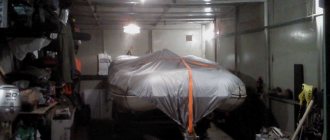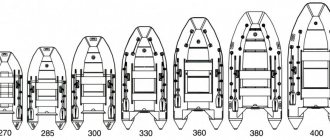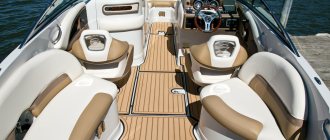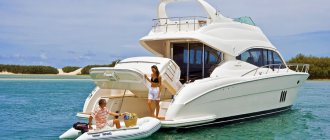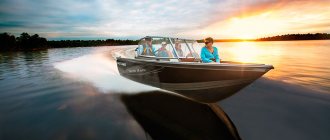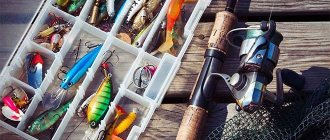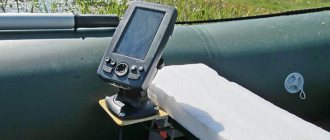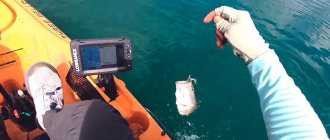An important element of any inflatable motor boat is the transom - a fairly rigid plate, which is intended primarily for mounting an outboard motor. The width of such a plate is equal to the width of the vessel or slightly less.
The transom must have considerable strength and withstand a number of loads, in particular the load from the motor used. It must also be technically compatible with the overall design of a particular boat model.
If we consider plastic and aluminum boats, they are necessarily equipped with a powerful built-in transom, on which high-power motors can be installed. But this article will focus specifically on the transoms of inflatable boats; read on for more details.
Boat transom height
The standard deadwood height is 381 mm, but even in engines from the same manufacturer it can differ by 20-25 mm. Thanks to the optimal position of the motor, you can increase the speed of the boat and reduce splashes behind the stern.
If you are interested in motors, propellers, pumps, and other accessories for boats and boats, we recommend the online store - vodnik.1000size.ru
If you are installing an engine and the anti-cavitation plate is below the recommended limits, you can loosen the screws and set the desired transom height, and then carry out test runs, having already secured the plate.
If you need to replace an outboard motor, you can adjust the transom to the features of the new engine, namely the length of its deadwood. Unnecessary holes for screws can subsequently be sealed with sealant, and then the desired motor mounting height can be selected, securing the plate in the desired position.
If the height is chosen correctly, you can achieve an increase in boat speed through such procedures. At the same time, fuel consumption and splash formation will also decrease.
Features of transom mounting
Depending on the method of attachment to the boat, the transom can be mounted or stationary. Mounted options in most cases are used for engines of relatively low power, since such a mount is not capable of withstanding significant loads. There are several ways in which canopy transoms can be attached:
- Fixation using rigid brackets to the cylinder located in the stern. While the boat is not fully inflated, the fasteners are put on the cylinder, after which the craft is fully inflated. The air pressure keeps the transom well in the desired position. However, this method is used less and less, since with the slightest drop in pressure both the transom and, accordingly, the engine become mobile.
- Two polyvinyl chloride tapes with holes for lacing. In this case, the transom rests on one plane against the stern, and is additionally secured with a strip of durable PVC material, being in it like in a kind of pocket. The method is quite common, as it is used by many boat manufacturers.
- By means of special plastic fasteners glued to the stern of the craft. This is also a common option, characterized by simplicity and reliability, which is why it is used by many manufacturers.
Some boats have a stationary transom. Due to the greater strength of the structure, it becomes possible to install a motor of greater power than in the case of mounted ones. However, it should be taken into account that the transom height will not fit all motors, and in some cases the question arises of how to fit the motor to the boat. Stationary structures can be secured as follows:
- Using brackets to the bottom of the boat and sides. This method is able to withstand even loads and vibration created by fairly powerful engines.
Often the transom is located at a slight angle to the axis of the cylinders. This is a design feature that ensures normal conditions for engine operation when moving the boat in planing mode.
fishelovka.com
Owners of boats made of PVC material often have the idea of upgrading their small boat and making it faster or at least more comfortable and convenient. Unfortunately, when purchasing, many people buy boats without a motor and transom, relying only on oars. But the desire to ride with the breeze is great and therefore you will have to correct this mistake and purchase a motor and a hinged transom for your boat separately.
But, if everyone has heard about the engine (motor), then what is a mounted transom? And is it worth paying such close attention to his choice? First, let's define the terms. A mounted transom is a special design that will give you the opportunity to independently secure the engine to the boat.
Basic criteria for selecting mounted transoms
When buying this important element of boat equipment, you should understand some circumstances: the stern of the boat must be trapezoidal in shape;
the motor must be correctly mounted on the transom in the desired position; It is better to choose a transom according to the principle: average or high price + excellent quality As for the last point, I would like to clarify why the transom needs to be selected carefully, and not spare money on it. e transoms, despite their similar appearance, differ in workmanship, price and manufacturer.
When choosing, you should not pay attention to cheap models, because in the end it will cost you more. Due to inappropriate savings when purchasing, it may happen that your transom or fasteners accidentally break, and you risk hitting the boat with a propeller and drowning the motor. You should also be aware that the transom is subject to high levels of vibration, which is known to occur during engine operation. This leads to loosening of bolts and other fasteners (they could be poorly tightened). To prevent this from happening, you should always use lock washers or lock nuts when fastening. For the same reason, you should not equip a boat with an engine with a power higher than 3.5 l/s - it is simply dangerous. For more powerful engines, there are boats with stationary (glued-in) transoms. When choosing such a boat, pay attention to how the transom is reinforced. If it is glued in with a rubber gasket or rim, this will help smooth out vibrations from the engine, and such a boat will last you longer. Transom sizes
Manufactured transoms are produced in one system of standards: height 381 mm - S (for PVC boats);
height 508 mm - L (for boats); height 635 mm - XL (for large yachts) To choose a reliable transom for a PVC boat, when purchasing you should pay attention to some important points: the thickness of the transom; painting; incline; protection It is recommended to choose the thickness of the transom based on the power of your engine. For boats with engines up to 15 l/s. usually purchase transoms with a thickness of at least 25 mm. If you have a more powerful motor, then the transom should be 35 mm or thicker. The slope of the transom is also important during installation and should be between four and six degrees. When purchasing, carefully inspect the transom you are purchasing to ensure there are no cracks or other damage. What this could mean was stated above. How to choose a PVC boat with a hinged transom
When choosing, first of all, decide what your goal is for your purchase? Where do you plan to use your boat? If you need a watercraft for walking short distances, then it is best to purchase an inexpensive option made of unreinforced PVC (from which air mattresses, children's toys, etc. are made). If you are going to travel on a stormy sea or river, go fishing or hunting, then buy a boat made of reinforced PVC, which is much stronger than the previous material. How many people will you take with you? If the boat is for one person, then it should be from 3 meters long, for two - up to 4.2 m, for three - more than 4.2 m. Determine what is better for you: so that the boat is more convenient to transport or so that it was it more comfortable? There are boats with increased weight. In addition to the main elements, they also have an additional bottom added. It can be aluminum or waterproof plywood. Such a bottom will make your boat more stable on the water. But on the other hand, a lightweight inflatable bottom is more convenient for transportation.
Types of transom by mounting method
The question arises of how to classify transoms, depending on their attachment to the hull of the boat. According to this principle, they are divided into glued and removable: Glued transoms are usually used on boats with more powerful engines that have a hard bottom and keel. Removable transoms are installed on boats with outboard motors, where the engine power is low. So, based on the results of this short review, we can conclude that purchasing a mounted transom for an engine is a very responsible procedure that does not forgive mistakes. But, if you make the right choice, then your boat, thanks to the new engine, will glide across the water surface much faster.
tahometr.com
Active recreation in nature has always been and remains the best way to unwind, get away from the bustle of the city, gain strength and positive impressions that a person needs for good emotional tone in everyday life. No matter how leaps and bounds technological progress moves forward, no matter how values change and no matter what happens in cities, man, first of all, remains the king of nature, which, despite his constant employment, he regularly needs.
From time immemorial, hunting and fishing have been and remain one of the favorite ways to spend time in Russia; Nowadays, in specialized stores you can find all the necessary equipment for these types of outdoor activities. And of course, neither serious fishing nor hunting is complete without inflatable boats. In this article we will talk about how to choose the right inflatable boat and which of its characteristics you should pay attention to first.
Inflatable boats have plenty of characteristics. Experienced fishermen and hunters have long figured out from their own experience what’s what, but if you have not yet become an avid lover of outdoor activities of this kind, you will definitely need help or advice. After all, there are inflatable boats: rowing, motor, motor-rowing, with and without a keel, with different types of deck and transom, and of course, with different carrying capacity. Many questions may arise, but perhaps the most common of them is: what is a transom and what does its height affect?
The transom is the plate at the rear of the boat on which the motor is mounted. There are stationary and suspended types of transom. The higher the transom, the more power the motor installed on it can have. This means that the height of the transom board directly affects the speed of the boat, the amount of spray during movement, fuel consumption and the ability to go on planing. Such a seemingly inconspicuous detail is so important! Some amateur fishermen independently change the height of the transom, “increasing” it, but still, in order to reduce hassle, it is better to immediately choose an inflatable boat with a suitable height of the transom board.
The standard transom height may vary between different manufacturers by 20-25mm, but the most common values are: 381, 508, 635 mm. If the length of the motor leg matches the height of the boat transom, excellent speed performance can be achieved.
Suspended transoms are usually used on oversized inflatable boats with low-power motors (up to 5 hp). If your goal is fishing or hunting in a small friendly company of up to 3 people, then you should pay attention to PVC boats with a suspended transom. The transom is usually made from durable, moisture-resistant plywood. Its height on boats of this type is usually 381 mm.
Fixed transoms are often found on motorized inflatable boats and are suitable for more powerful engines. Inflatable boats with stationary transoms can be quite functional and very spacious - some models (such as the Altair Pro Ultra 425 PVC inflatable boat) can take up to 8 people on board and can be equipped with motors up to 30 hp. The transom height on such boats is also 381 mm. A transom with a height of 508 mm is found on specialized rescue and fishing boats 4-6 meters in length, and a height of 635 mm is found on serious fishing vessels and yachts.
When choosing an inflatable boat, you should also pay special attention to the width of its cockpit. The cockpit is an open space on the deck designed to accommodate passengers and hand luggage. The wider the cockpit, the greater the capacity of the boat.
Boats with a more powerful engine usually have an inflatable keel, which improves the boat's seaworthiness, stability on the water and maneuverability. On the simplest oversized motor-rowing boats with a capacity of 1 to 2 people, there may be no keel, which, in principle, is natural, since such models simply do not need it.
When choosing an inflatable boat, first of all you should decide what you need it for: for fishing/hunting in a company of up to 3 people, for traveling in large groups, for rafting on stormy rocky rivers or going out to calm small lakes? This will determine whether you need a more or less powerful boat, with a hard or inflatable bottom, motorized or oared, with or without a plywood floor. If you still don’t know which inflatable boat to choose, call us and the best consultants will be happy to answer all your questions.
You can find the full range in the PVC Boats section
zashturvalom.ru
Motorboats around the world are manufactured with a generally accepted transom height , which ensures compatibility between boats and outboard motors of different brands.
There are 4 transom height options.
Transom height S (standard) - 15 inches - 381 mm . Boats with a standard transom height are the most common on the powerboat market. These are almost all inflatable PVC boats, small plastic and wooden boats and dinghies.
Most outboard motors are made for boats with a standard transom. The length of the leg of such a motor (“short leg”) varies depending on the brand of the motor and is designed so that the propeller and anti-cavitation plate are immersed in water.
Transom height L (long) - 20 inches - 508 mm . This transom height is often found in small sea vessels: boats, yachts, sailboats . The high transom and sides of the boat protect passengers from splashes when traveling in open waters.
For boats with transom height L, outboard motors with a “ long leg ” are used. The names of such engines always include the Latin letter L , for example Tohatsu MFS9.8 L.
Transom height UL (ultra-long) or X - 25 inches - 635 mm .
Transom height XX - 30 inches - 762 mm .
Marine boats designed for gasoline engines with a power of more than 200 hp have this transom height. .
motorka.pro
Hard transom boat
There are many important differences between the designs of motor boats and rowing boats. Boats designed for use with an outboard motor have a rigid transom, which is used to mount the motor. Motor boats differ in engine power and bottom design features.
In boats that are designed to use a small engine with a power of 2-3 hp, the bottom is made inflatable or reinforced with transverse slats, while boats with more powerful motors have rigid floors, making it easier and safer to plan at high speeds.
There is another type of boat - Rigid Inflatable Boats (RIB), “rigid inflatable boats”. These inflatable boats have a V-shaped bottom made of plastic or aluminum. This type of boat is characterized by a number of advantages, including the presence of a durable bottom, the ability to use engines with power up to 150 hp, and high speed. In addition, RIB boats are not too heavy.
Do-it-yourself PVC boat mounted transom
The transom is where the outboard motor is mounted. It must be a reliable, firmly fixed structure. Therefore, the manufacturing process cannot be approached irresponsibly. This element must not be allowed to be unstable and not durable. Mistakes on the water can end in disaster. This is especially true when there are several people in the boat and their well-being depends on this structural element.
When carrying out work, you should strictly adhere to the basic recommendations, taking into account the technical characteristics of the PVC boat along with the motor that will be attached to this element.
Homemade transom for a rubber boat.
Watch this video on YouTube
Motor and transom
The transom for an inflatable boat is designed exclusively for a specific model of an inflatable boat, since boat designs come in a variety of sizes and vary in size. As a rule, those boat models that are sold without an engine and designed for oaring are not allowed to install an outboard motor more powerful than 3 horsepower. Such a motor will allow you to move in an inflatable boat through the water at speeds of up to 10 km/h. Such inflatable boats have limitations related to the weight of the motor. By and large, such boats are not designed to have outboard motors installed on them.
Before starting work, you should carefully study the technical data of the PVC boat and the motor in order to correctly calculate the suspended transom.
Since the boat is not large, the transom is an additional load, especially with a motor. At the same time, you need to take into account that the boat is made of thin PVC material.
And yet, such a transom is capable of supporting a boat motor with a power of up to 3 horses, which contributes to more comfortable fishing conditions. At the same time, you should carefully consider the entire structure, since it puts significant pressure on the stern of the boat. The more powerful the engine, the greater its mass and the greater the load it puts on the material of the boat.
Transom design
As a rule, a hinged transom for a boat is a very simple design consisting of:
- From a plate.
- From fastening arches.
- From the rings, which are also called bubyshki.
The plate is made from a plate and can have any shape. Mounting bows are brackets that are attached to both the plate and the boat using eyelets.
The eyelets have a unique design, consisting of special brackets that have a flat base.
Materials for production
Only waterproof plywood is suitable for making the plate. It is quite light and durable, and at the same time has a polished surface that can protect the structure from negative natural factors.
For the manufacture of staples, rolled steel is used, which is bent depending on the given shape. The best option is to use stainless steel or steel with a special coating (chrome, nickel, zinc).
The presence of steel elements allows you to create a durable structure that is resistant to deformation. If the elements have a protective coating, the structure is durable and protected from corrosion.
The eye is made of plastic, which is characterized by lightness and resistance to moisture, as well as other negatives. In addition, the plastic easily adheres to the PVC base from which the boat is made. For fastening, only moisture-resistant glue should be used.
Manufacturing
All work begins with a drawing. Moreover, a drawing of the simplest transom design will do.
For the plate, plywood with a thickness of 10 mm is used. The edges of the plate should be sanded to avoid damaging the boat. Loops are attached to the plate, which will serve as a fastener for metal brackets.
The fastening arcs are bent manually or on a machine.
Eyes are purchased separately; if all the parts are ready, then they should be installed on the boat.
BEST DIY Canopy Transom!
Watch this video on YouTube
Boat transom thickness
For the safe and efficient use of an inflatable boat, the technical characteristics of the transom itself are important. First of all, this concerns its thickness, the angle of inclination during installation, as well as the quality of the transom coating.
When it comes to the thickness of the transom, the main role is played by the maximum power of the engine that will be installed on the boat in the future. For example, if you plan to install a motor with a power of up to 15 hp, then the transom should have a thickness of at least 2.5 cm. If the motor used is even more powerful, the thickness should be 3.5 cm or more.
How to choose a transom for a rubber boat
When choosing a transom for a rubber boat, you need to formulate the purpose of using the floating product. If you need a boat for fishing in a company of 3 people, then a suspended transom is quite suitable. Typically the height of such a transom is about 381 mm. When there are more people (5-8 people), it is better to choose an inflatable boat with a stationary transom. Firstly, a more powerful engine can be attached to it. Secondly, such a boat will be more comfortable. The height of such a transom also does not exceed 381 mm. With the exception of rescue and fishing boats. On them the transom can be 508 mm.
Boat transom angle
The angle of inclination of the transom also plays an important role. Its limits are 4-6 degrees. Such indicators are calculated for the use of imported motors, which are most often used in our territory.
Fulfilling the specified conditions for tilting the transom will improve the performance of the propeller, and at the same time will have a positive effect on the speed of the boat and reduce fuel consumption. In addition, the above angle of inclination practically eliminates the risk of the propeller catching air.
Mounted transom (video)
Mounting an echo sounder on the transom of a boat
Having purchased a brand new echo sounder, fishermen often have problems regarding the mounting of the device. Of course, the instructions suggest attaching the echo sounder sensor permanently to the transom. But, as you know, accuracy in mounting the sensor is very important for its effective operation. In addition, a stationary mount may simply be inconvenient.
To solve the problem, you can use a removable bracket-holder on the pipe. Such brackets can be easily attached to almost any transom, without much effort or special tools.
Author of the article: Vitaly Leonidovich Ivanov, 2021.

